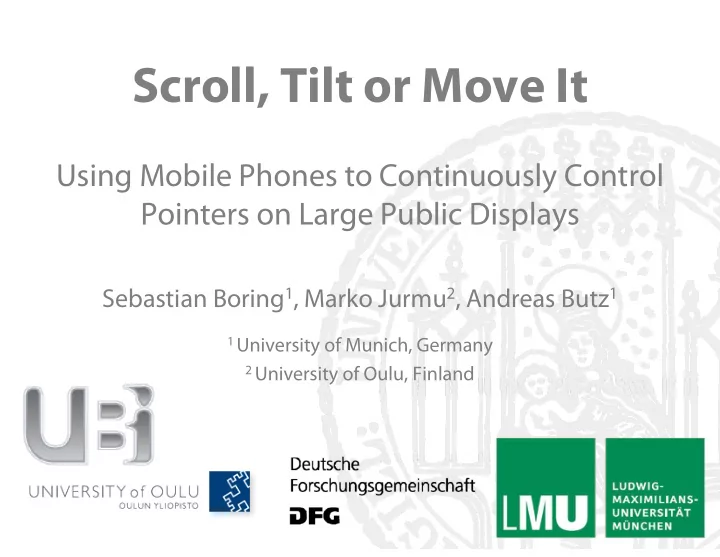

Scroll, Tilt or Move It Using Mobile Phones to Continuously Control Pointers on Large Public Displays Sebastian Boring 1 , Marko Jurmu 2 , Andreas Butz 1 1 University of Munich, Germany 2 University of Oulu, Finland
motivation
motivation
how to interact? How can we use mobile phones as pointing device?
related work Discrete & Ballagas, et al. (CHI 2005) Absolute Interaction Boring, et al. (Mobility 2007) Madhavapeddy, et al. (Ubicomp 2004)
related work Jiang, et al. (CHI 2006) Miyaoku, et al. (UIST 2004) Continuous & Absolute Interaction Pears, et al. (VisApp 2008)
related work Which one is the best? Silfverberg, et al. (GI 2001) Ballagas, et al. (IEEE Pervasive Computing 2006) Vajk, et al. (Computer Games Technology 2008)
relative pointing Move Scroll Tilt Camera s Keypad r o s n e S
scroll Movement Ratio: 200 px within 1 second
tilt Speed: dependent on tilting angle
move Speed: dependent on phone movement
prediction
evaluation Select Targets on a Remote Display
task Hover on Target Move to Target Click Start Button
target sizes 72 px 48 px 24 px
target distances 96 px 336 px
target directions Diagonal Linear
apparatus Screen Size: 50” (16:9) 1106 x 622 mm Resolution 1366 x 768 pixels Viewer Distance: 1.5 m
study design [ 3 Techniques × 3 Target Sizes × 2 Target Distances × 8 Target Directions] = 144 combinations 3 Repetitions for each combination � 432 data points per participant 12 participants in our study
hypotheses H1: Move performs better than Tilt for all sizes, directions and distances H2: Move performs better than Scroll for larger targets and high distances H3: Move and Tilt have higher error rates than Scroll for small targets (regardless of the target’s distance)
results: task time
results: task time
results: error rates
results: error rates
overshooting effect Placement: NW, Distance: 336 pixels
discussion All hypotheses were supported! Move and Tilt both suffered from slight phone movement during selection Tilt introduced “skill” component Fatigue was highest for Move!
conclusions Three relative pointing techniques: Scroll, Tilt and Move Tilt and Move are faster but introduce several errors � need to be improved Overshooting effect needs to be addressed to decrease error rates!
future steps Improve the techniques: Use snapping to prevent overshooting. Use the winning candidate to compare personal versus public control placements.
acknowledgments People: Otmar Hilliges, Bettina Conradi, Dominikus Baur and all OzCHI reviewers Funding: DFG, Ubi Program and the participating companies, GETA, TES and the German state of Bavaria
end sebastian.boring@ifi.lmu.de Sebastian Boring Questions?
Recommend
More recommend